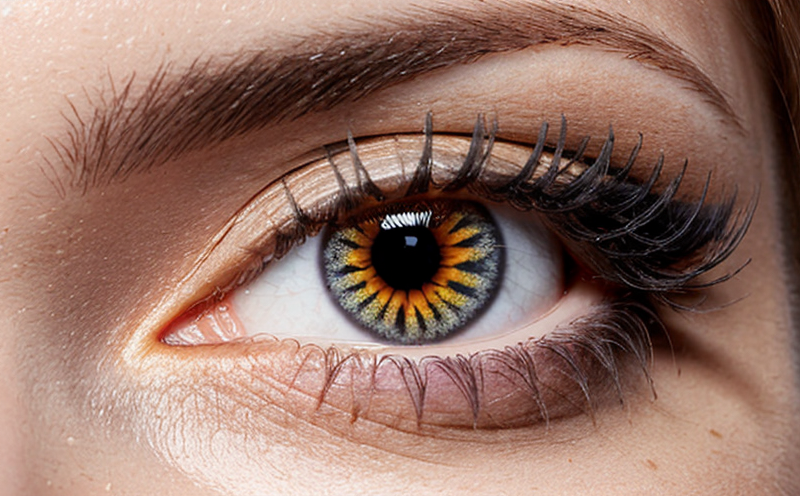In Vitro Ocular Toxicity Testing of Cosmetic Ingredients
The in vitro ocular toxicity testing of cosmetic ingredients is a critical step in ensuring that products are safe and do not cause harm to consumers. This method replaces the traditional animal-based tests, which have been phased out due to ethical considerations and advancements in alternative testing methods. The primary objective of this testing is to evaluate how potentially harmful a substance could be when it comes into contact with ocular tissues.
The process involves exposing cells or cell lines derived from human ocular tissue to the cosmetic ingredient being tested under controlled conditions. This allows for the assessment of potential irritation, inflammation, and other adverse effects on the eyes. By using this approach, companies can comply with regulatory requirements such as those set by ISO and the European Union's Cosmetics Regulation (EC No 1272/2008).
The choice of test depends on the specific ingredient or formulation being evaluated. For instance, some tests may focus solely on the ocular surface cells, while others might include a more comprehensive analysis involving multiple layers of eye tissue. The testing can also be conducted using various endpoints such as cytokine release, cell viability assays, and gene expression profiles.
Preparation for these tests requires careful selection of the appropriate cells or tissues, along with precise handling to ensure that they remain viable throughout the experiment. Once prepared, the samples are exposed to the cosmetic ingredient under study, followed by a series of observations over time. These observations help determine whether there is any sign of toxicity or adverse effects.
After completing the tests, detailed reports are generated summarizing all findings. These reports serve as essential documentation for regulatory submissions and internal quality control processes. They also provide valuable insights into the safety profile of new ingredients early in development stages, allowing manufacturers to make informed decisions about further testing or modifications needed before proceeding with clinical trials.
This type of testing plays a crucial role in safeguarding public health by identifying potentially dangerous compounds early on so that safer alternatives can be developed and marketed. It contributes significantly towards reducing reliance on animal models while maintaining high standards for product safety.
Some key benefits include reduced costs associated with fewer failed products during later stages of development, faster time-to-market due to streamlined regulatory compliance processes, enhanced reputation among consumers who value ethical practices in manufacturing, and increased confidence from investors seeing long-term financial returns through sustainable business models.
Quality and Reliability Assurance
The quality and reliability assurance of our in vitro ocular toxicity testing services are paramount to maintaining industry-leading standards. We employ state-of-the-art equipment and highly trained professionals who adhere strictly to internationally recognized guidelines such as ISO 17025:2017 for laboratory accreditation.
- Our facilities meet stringent quality control measures ensuring consistent results across all samples processed.
- We maintain rigorous validation protocols to verify the accuracy and precision of each test conducted.
- A dedicated team oversees continuous improvement initiatives aimed at enhancing our methods further.
The reliability of these tests is further enhanced by regular calibration of instruments, participation in proficiency testing programs, and adherence to best practices recommended by relevant authorities like the European Pharmacopoeia and Good Laboratory Practice (GLP).
By focusing on excellence in every aspect of our operations—from sample preparation to final reporting—we strive to deliver accurate and reliable data that can be confidently used for decision-making purposes.
Environmental and Sustainability Contributions
In vitro ocular toxicity testing offers significant environmental benefits by eliminating the need for animal testing. This shift towards more humane approaches has been embraced globally as part of efforts to reduce suffering caused by experiments on live animals. By adopting this method, we contribute positively to sustainability goals by minimizing ecological impact associated with traditional testing practices.
Moreover, our commitment extends beyond just reducing harm; it encompasses broader environmental stewardship through efficient resource use and waste management within laboratory operations. We ensure minimal consumption of resources such as electricity and water while properly disposing of hazardous materials generated during testing procedures in accordance with local regulations.
The transition to non-animal methods also fosters innovation within the cosmetics industry by encouraging development of safer products without compromising effectiveness or efficacy. This encourages a culture of responsible production practices that prioritize both human health and planetary well-being.
Competitive Advantage and Market Impact
- Ethical Leadership: By leading the way in adopting humane testing methodologies, we position ourselves as leaders in corporate social responsibility (CSR).
- Regulatory Compliance: Our expertise ensures that clients stay ahead of changing regulations worldwide, avoiding costly delays or penalties.
- Innovation Hub: As pioneers in this field, we attract top talent and strategic partnerships, driving forward research and development activities.
- Market Differentiation: Offering unique services sets us apart from competitors, attracting discerning clients seeking excellence in every aspect of their business operations.
The implementation of our testing protocols not only enhances product safety but also strengthens brand reputation. Companies that demonstrate a commitment to ethical practices often find greater consumer loyalty and willingness to pay premium prices for products perceived as environmentally friendly and socially responsible. Additionally, early identification of potentially harmful ingredients allows brands to innovate quickly by exploring safer alternatives, giving them an edge over competitors who might still rely on outdated methods.
Our services play a vital role in fostering trust between consumers and manufacturers by ensuring that every product released meets stringent safety standards. This builds long-term relationships based on mutual respect and shared values, ultimately contributing to the success of our clients in competitive markets.





